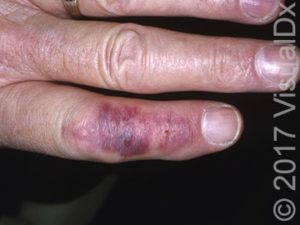Published on
Differential Diagnosis
- Fire ants
- Lyme disease
- Spider bite
- Wasp sting

Diagnosis
This woman suffered multiple stings from a wasp. Because their stingers do not have barbs, as a bee’s stinger does, wasps are able to sting repeatedly. This is most likely to occur when they’re trapped in clothing (or, in this case, a tent).
Learnings
- Wasp venom contains enzymes, small peptides, and amines. Allergens include phospholipases, hyaluronidases, and cholinesterases
- Some peptides cause histamine release by degranulating mast cells; histamine, along with serotonin and acetylcholine, contribute to the pain associated with wasp stings
- Anaphylactic reactionscause diffuse urticaria, pruritus, angioedema, bronchoconstriction, respiratory distress, hypotension, loss of consciousness, and cardiac arrhythmias
Pearls for Urgent Care Management and Considerations for Transfer
- Life-threatening, anaphylactic signs typically occur within 10 minutes of the sting. Patients who present days or even hours after a sting should receive symptomatic treatment geared toward reducing discomfort
- Wash the area of the sting with soap and water to remove as much venom as possible
- Apply cold packs to reduce swelling and pain
- Keep the wound clean and dry to prevent infection
- A bandage may be used to cover the wound
A 34-Year-Old Woman with an Unidentified Insect Sting
1 2
